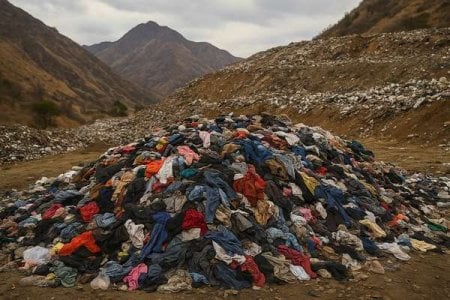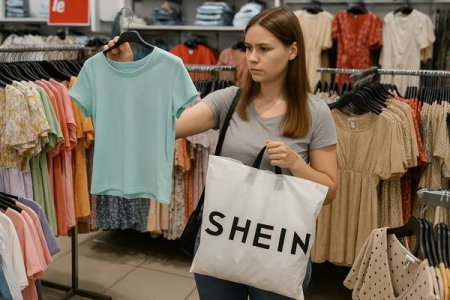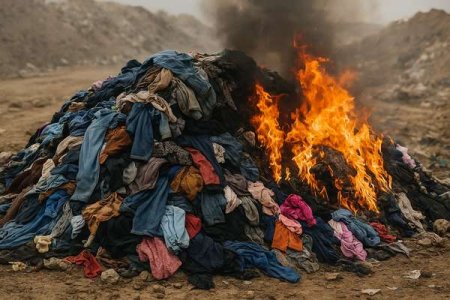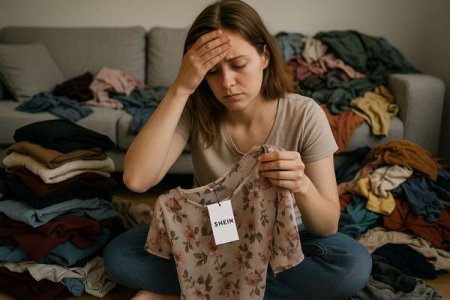FAST AND CHEAP: Will this retail addiction in Australia bite back hard soon?
By
Danielle G.
- Replies 0
Australians love a good bargain. Whether it’s a $5 t-shirt from an online sale or a pair of jeans cheaper than yesterday’s lunch, the fast fashion frenzy has swept up shoppers of all ages. But for all the thrill of snagging a deal, there’s a hidden cost piling up – often out of sight and out of mind. Every year, more than 200,000 tonnes of clothing end up in Australian landfills – that’s nearly four Sydney Harbour Bridges worth of garments tossed away annually. And it turns out we’ve earned an unenviable title: per person, Australians buy more new clothes than any other country on Earth. Yes, we’ve even out-shopped the Americans. Now experts and advocates are asking whether it’s time for Australia to curb its fast fashion habit with some much-needed rules and a return to “clothing that lasts.”
On average, each Australian purchases 56 new pieces of clothing a year, often cheap, trendy items that wear out or fall out of style quickly. Walk into any big retailer or scroll through online marketplaces, and you’ll see why – racks of tops and dresses for the price of a coffee. The average Aussie garment costs just $13 (far lower than in the US or UK), reflecting our appetite for cheap, fast fashion over pricier, longer-lasting pieces. We’re buying more clothes than ever, but wearing each item for a shorter time.
It wasn’t always this way. Many readers might recall a time when a new coat or a pair of boots was an investment – something you’d save up for and expect to use for years. As one retail expert lamented, “Clothing items used to be made to last, now they are made to replace, and quickly”. The fast fashion model has completely flipped our mindset: today’s shoppers chase the latest styles and “haul” videos on social media, stocking up on cheap outfits that might only be worn once or twice. The result? Our wardrobes are overflowing, and so are our bins. In fact, the average Australian disposes of 23 kilograms of clothing each year – about the weight of a full suitcase – most of it ending up buried in rubbish tips.
This glut of discarded clothes is fueling a national waste crisis. We tend to feel better about clearing out our closets by donating to charity shops, but there’s only so much second-hand demand. Charities can resell only about 15% of the clothes they receive locally; the rest often winds up shipped overseas or dumped in landfill. **Australia now sends over 100,000 tonnes of used textiles offshore each year, where much of it becomes waste in developing countries – a practice critics dub “waste colonisation”. From the Atacama Desert in Chile to landfills in Africa, piles of our cast-off clothes are forming mountains of waste abroad as well.
For a country that prides itself on natural beauty and a “fair go” ethos, this fast fashion free-for-all is starting to look pretty unfair – both to the planet and to people. And it’s raising an uncomfortable question: have we become addicted to cheap clothes, and who’s really paying the price?
It might feel great to snag a $10 shirt, but fast fashion’s environmental price tag is anything but cheap. The textile industry is one of the most polluting industries globally, responsible for an estimated 8–10% of all global carbon emissions – more than all international flights and shipping combined. Producing endless streams of trendy garments gobbles up resources: the fashion sector uses 93 billion cubic metres of water per year, and relies heavily on synthetic fabrics like polyester (a plastic derived from petroleum). When those synthetic clothes end up in landfill, they can take centuries to decompose, all the while leaching chemicals and shedding microplastics into soil and waterways. Decomposing clothes in dumps even release methane, a potent greenhouse gas, contributing to climate change.
Here in Australia, the fast fashion waste avalanche is growing. Since 2000, global clothing production has doubled, and consumers worldwide now buy 60% more garments than 15 years ago but keep them for half as long. Aussies exemplify this trend. We’re now the world’s second-largest consumers of textiles per person (behind only the US), and our throwaway habits mean most of those garments end up discarded within a year of purchase. As sustainability advocate Nina Gbor points out, “many of these items end up in landfill or are dumped in countries in the Global South, where they fill up landfills, pollute beaches and oceans and contribute to more emissions”. In other words, our bargain t-shirts and $2 socks aren’t just straining Aussie landfills – they’re becoming a global garbage problem, turning once-pristine deserts and shores into textile trash heaps.
There’s also the less-visible human cost woven into those cheap stitches. The fast fashion industry runs on razor-thin margins and rapid production, which often means outsourcing to factories in low-wage countries. Labour rights groups have long documented exploitative conditions: from Bangladesh to China, garment workers – mostly women – have faced poverty wages, excessive hours, unsafe conditions, even child labour in some factories. Tragedies like the 2013 Rana Plaza factory collapse in Bangladesh, which killed over 1,100 workers, spotlighted these harsh realities. While big brands have since pledged improvements, investigative reports still uncover instances of abuse. A recent probe found some suppliers to ultra-fast fashion giant Shein forcing employees to work up to 75 hours a week for meagre pay. In the UK, another fast fashion hub, factories subcontracting for popular brands were caught paying as little as £3.50 an hour – far below minimum wage. In short, the true price of a $5 dress may be borne by underpaid workers and polluted communities on the other side of the world. As the old saying goes, “there’s no such thing as a free lunch” – someone, somewhere, always picks up the tab.
If one company exemplifies the extreme ends of fast fashion’s promise and peril, it’s Shein. The Chinese-founded, online retailer has taken the world (and Australia) by storm in just a few years, thanks to jaw-droppingly low prices and an endless torrent of new styles. Shein only began shipping to Australia in 2022, yet it quickly won over millions of Aussie shoppers on a budget. Scroll through its app and you’ll find dresses for $8, tops for $4 – temptation for anyone feeling the pinch of the cost-of-living. The company’s formula? An on-demand, tech-driven supply chain that can take a design from concept to production in as little as 10 days. In Guangzhou’s maze of factories – nicknamed “Shein Village” – an army of suppliers churns out small batches of thousands of designs, guided by real-time data on what’s trending. If a style sells well, they produce more; if not, they move on. By adding up to 10,000 new items to its site each day, Shein ensures there’s always something new to catch the eye of trend-hungry consumers.
This ultra-fast model, supercharged by TikTok and YouTube “haul” videos, has been wildly successful commercially – Shein’s global revenue hit an estimated $32.5 billion in 2023, with about 88 million active customers worldwide. Chances are, if you have teenage grandkids, you’ve heard them gush about their latest Shein parcel or seen the haul videos where young influencers proudly display dozens of cheap outfits in one go. It’s the new form of entertainment-driven shopping, and Australian shoppers have jumped on board.
But Shein has also become the case study in fast fashion’s downsides. Critics argue that its business model – flooding the market with ultra-cheap, disposable clothing – is inherently unsustainable. Environmentalists note that Shein nearly doubled its carbon emissions in 2023 alone, propelling it to “the biggest polluter in the industry.” The company has announced lofty goals to cut emissions 25% by 2030 and reach net-zero by 2050, but skeptics point out that those pledges ring hollow while Shein keeps accelerating production at breakneck speed. Indeed, climate researchers warn that using AI to turbocharge fast fashion could be “cranking up emissions” even higher.
Shein’s response to such criticism is telling. The company insists “it is not a fast fashion company”, claiming its on-demand production reduces waste by avoiding unsold inventory. “Our focus on quality and value is why millions of Australian consumers choose Shein,” the brand stated, also highlighting investments in recycled fabrics and a science-based net-zero target. In plainer terms, Shein argues that it’s giving the people what they want – affordable clothes – and working on being greener, so heavy-handed regulations (like bans on advertising or new taxes) are not the answer. It’s a familiar defense: we’re just meeting consumer demand, and we’ll voluntarily innovate to fix any problems.
Still, one can’t ignore the bigger picture. Shein’s rise has put a spotlight on the ultra-fast fashion era, where hundreds of thousands of styles are available at our fingertips, prices are at rock-bottom, and the turnover of clothes in our closets has never been quicker. It perfectly illustrates the central dilemma: fast fashion fulfills our desire for variety and bargains – but at the cost of enormous waste and ethical compromises. That brings us to the crux of the debate here in Australia: what, if anything, should we do about it?
Before diving into solutions, it’s worth asking: why are Aussies so hooked on fast fashion in the first place? The answers aren’t all frivolous. Affordability is a big one. With the cost of living biting (everything from housing to lettuce is pricier these days), it’s hard to pass up $10 jeans when the boutique pair costs $100. Fast fashion has democratised style – you don’t need a big bank account to dress in the latest trends. For retirees on fixed incomes or families watching every dollar, cheap clothing can feel like a lifesaver. Even sustainability advocate Nina Gbor acknowledges the appeal, noting how Shein shoppers often spend “hundreds of dollars for a haul” to refresh their wardrobe. The haul culture promoted by influencers makes shopping a form of cheap thrill and social media entertainment.
Variety and convenience play a role too. The days of seasonal fashion are gone; now there’s a new micro-trend every week on Instagram. Fast fashion retailers excel at offering an endless carousel of styles – catering to every taste, size, and whim – delivered to your door with a click. For older Australians who might remember saving up for a special outfit, it’s astonishing how quickly you can order a whole new look online today. The convenience is addictive.
Marketing cannot be overlooked either. We’re constantly nudged to buy. Social media feeds are flooded with fashion influencers showing off “just a few cheap finds.” Big retailers email out weekly sales. It creates a sense of urgency – the fear of missing out on a deal or a trend. And while younger Aussies are the main targets on TikTok and YouTube, seniors are not entirely immune (who hasn’t wandered into Kmart “just to look” and come out with two $8 shirts because why not?). Retail therapy is real, and fast fashion makes it easier than ever.
However, there’s a flip side: quality, or the lack thereof. Many of those ultra-cheap clothes simply don’t hold up. “Cheap (and mainly imported) T-shirts lose shape, stain easily, fade, and fall apart in the wash,” notes sustainable fashion consultant Julie Boulton, explaining why basics like tees are among the most frequently discarded items. In other words, buying cheap often means buying twice. Older generations might be familiar with this concept – the old adage “you get what you pay for” often holds true. The cycle of constantly replacing flimsy garments can trap consumers in a loop that ultimately costs more in the long run (and creates more waste). So while fast fashion offers a quick fix to our budget and style cravings, it may also be quietly eating away at our wallets and patience when clothes fall apart.
There’s also an ethical tug-of-war in many shoppers’ minds. Plenty of Australians care about doing the right thing – a recent poll found 63% of people are concerned about the environmental impact of textile waste. Most believe businesses should bear responsibility for reducing that waste, followed by consumers and government. Yet when you’re standing in a store (or browsing online) and see a bargain, those big-picture ethics can fade against the immediate perk of saving money. It’s a classic consumer conundrum: we want to make ethical choices, but we also want an affordable new outfit for Friday night. And truth be told, not everyone has the time or means to research brands or sift through op-shops for alternatives.
Still, advocates like Nina Gbor argue that cost is not an excuse to stick with wasteful fashion habits. “I do not sympathise… with people who say, ‘Oh, we’re in a cost-of-living crisis, all I can afford is fast fashion,’” Gbor says bluntly. “You can host a clothes swap, get clothes for free. We have op-shops, second-hand markets… I don’t buy that excuse”. She and others promote creative solutions: swapping clothes with friends, buying second-hand, mending and upcycling old garments – all time-honoured practices that can save money and reduce waste. Our grandparents were experts at this kind of thriftiness and “make-do” approach. Perhaps the fast fashion era has something to learn from them.
With the downsides of fast fashion piling up (sometimes literally), many experts are saying it’s time for a policy intervention – essentially, for the government to step in and put some guardrails on this runaway industry. Left to its own devices, the market has given us plentiful cheap clothes, yes, but also mountains of waste and questionable labor practices. So what would reining in fast fashion look like? Around the world – and increasingly in Australia – a few big ideas are on the table:
Not everyone agrees with heavy regulation, of course. The fashion industry and some consumers have reservations. When France announced its fast fashion tax plan, Shein complained that it would “worsen the purchasing power of [consumers]… at a time when they are already feeling the cost of living crisis”. In plainer language: making cheap clothes less cheap could hurt people who rely on them. Temu, another Chinese e-commerce player known for low-cost goods, argued that it’s “not a fast fashion brand” but just a marketplace helping Aussies “stretch their dollar”, and warned that taxes might do more harm than good. These companies – and many shoppers – worry that poorly designed rules might mean higher prices, fewer choices, or even lost jobs in garment factories overseas that depend on large orders. It’s a valid concern: if fast fashion slows down, what happens to those workers in countries like Bangladesh or Vietnam? Ideally, the industry would shift to quality-over-quantity and create better jobs, but transition periods can be bumpy.
So, there’s a balancing act here for policymakers. How do we make fashion more sustainable without unduly burdening those who count on its affordability? Australia is watching experiments overseas (like France’s bold moves and new laws in states like California and New York aiming to enforce supply chain transparency). We’re also taking cautious first steps of our own (the voluntary stewardship scheme, gentle prodding of big retailers, etc.). It’s a national conversation in the making, and it’s reaching a point where everyday Aussies – including seniors – are increasingly tuning in. After all, many older Australians have witnessed dramatic changes in how we consume and dispose of things. There’s a sense that we’ve seen what happens when industries go unchecked (think plastics, or e-waste), and we know that reining them in early could save a lot of grief later.
What would Australians stand to gain if we put some serious checks on fast fashion? Here are some of the top benefits experts foresee from stronger regulation and a cultural shift in our shopping habits:
Of course, it’s not all smooth sailing. If Australia moves to regulate fast fashion more tightly, there will be trade-offs and challenges to navigate:
Despite these challenges, many believe the status quo isn’t an option. The waste is growing, the climate impact is undeniable, and public sentiment is slowly turning against “throwaway” culture. Yes, there will be trade-offs – but proponents argue that the cost of inaction will be far higher. As Lisa Asher warned starkly, “If we do not stop what we are doing, we will pollute the planet irreversibly in 30 years”. That’s well within the lifetime of both today’s seniors and their grandchildren. It puts things in perspective: those cheap clothes aren’t really “cheap” when you factor in the environmental debt we’re piling up.
Australia’s relationship with fast fashion is at a crossroads. On one hand, we relish the affordability, variety, and fun that come with being able to snag new outfits on a whim. On the other, we’re increasingly aware of the waste, pollution, and ethical quandaries stitched into the seams of those $5 bargains. The push for new rules – from taxes to advertising bans to quality standards – reflects a growing consensus that the industry can’t keep racing ahead unchecked. There’s a bit of déjà vu here for those who’ve seen other industries grapple with their dark side; much like we eventually tackled big tobacco ads or started charging for plastic bags, fashion could be next in line for a sustainability makeover.
What’s clear is that any solution must be fair and multifaceted. It’s about nudging companies to do better, and empowering consumers to make conscious choices, and building an infrastructure for recycling and reuse. The good news is that many of these ideas (clothing repair cafes, fabric recycling tech, slow fashion brands) are already percolating in our communities. Australians are nothing if not resourceful – we pioneered sun-smart campaigns and water conservation drives; perhaps we can add fashion waste reduction to our list of proud achievements.
In the end, it might come down to redefining what a “bargain” really is. Is it a $10 dress that you wear twice and bin, or a $50 dress you love for years? Is it saving money today, or saving our environment and dignity tomorrow? Striking a balance between enjoying fashion and being responsible is the challenge of our times. We owe it to ourselves – and future generations – to try for that sweet spot where style, sustainability, and affordability meet.
As we consider new rules and our own habits, it’s worth pondering a simple question: Can we have our fashion fix and a clean conscience, or will we finally have to choose what matters most?
Australia’s Love Affair with Cheap Fashion
On average, each Australian purchases 56 new pieces of clothing a year, often cheap, trendy items that wear out or fall out of style quickly. Walk into any big retailer or scroll through online marketplaces, and you’ll see why – racks of tops and dresses for the price of a coffee. The average Aussie garment costs just $13 (far lower than in the US or UK), reflecting our appetite for cheap, fast fashion over pricier, longer-lasting pieces. We’re buying more clothes than ever, but wearing each item for a shorter time.
It wasn’t always this way. Many readers might recall a time when a new coat or a pair of boots was an investment – something you’d save up for and expect to use for years. As one retail expert lamented, “Clothing items used to be made to last, now they are made to replace, and quickly”. The fast fashion model has completely flipped our mindset: today’s shoppers chase the latest styles and “haul” videos on social media, stocking up on cheap outfits that might only be worn once or twice. The result? Our wardrobes are overflowing, and so are our bins. In fact, the average Australian disposes of 23 kilograms of clothing each year – about the weight of a full suitcase – most of it ending up buried in rubbish tips.
This glut of discarded clothes is fueling a national waste crisis. We tend to feel better about clearing out our closets by donating to charity shops, but there’s only so much second-hand demand. Charities can resell only about 15% of the clothes they receive locally; the rest often winds up shipped overseas or dumped in landfill. **Australia now sends over 100,000 tonnes of used textiles offshore each year, where much of it becomes waste in developing countries – a practice critics dub “waste colonisation”. From the Atacama Desert in Chile to landfills in Africa, piles of our cast-off clothes are forming mountains of waste abroad as well.
For a country that prides itself on natural beauty and a “fair go” ethos, this fast fashion free-for-all is starting to look pretty unfair – both to the planet and to people. And it’s raising an uncomfortable question: have we become addicted to cheap clothes, and who’s really paying the price?
The Hidden Costs: Environment and Ethics
It might feel great to snag a $10 shirt, but fast fashion’s environmental price tag is anything but cheap. The textile industry is one of the most polluting industries globally, responsible for an estimated 8–10% of all global carbon emissions – more than all international flights and shipping combined. Producing endless streams of trendy garments gobbles up resources: the fashion sector uses 93 billion cubic metres of water per year, and relies heavily on synthetic fabrics like polyester (a plastic derived from petroleum). When those synthetic clothes end up in landfill, they can take centuries to decompose, all the while leaching chemicals and shedding microplastics into soil and waterways. Decomposing clothes in dumps even release methane, a potent greenhouse gas, contributing to climate change.
Here in Australia, the fast fashion waste avalanche is growing. Since 2000, global clothing production has doubled, and consumers worldwide now buy 60% more garments than 15 years ago but keep them for half as long. Aussies exemplify this trend. We’re now the world’s second-largest consumers of textiles per person (behind only the US), and our throwaway habits mean most of those garments end up discarded within a year of purchase. As sustainability advocate Nina Gbor points out, “many of these items end up in landfill or are dumped in countries in the Global South, where they fill up landfills, pollute beaches and oceans and contribute to more emissions”. In other words, our bargain t-shirts and $2 socks aren’t just straining Aussie landfills – they’re becoming a global garbage problem, turning once-pristine deserts and shores into textile trash heaps.
There’s also the less-visible human cost woven into those cheap stitches. The fast fashion industry runs on razor-thin margins and rapid production, which often means outsourcing to factories in low-wage countries. Labour rights groups have long documented exploitative conditions: from Bangladesh to China, garment workers – mostly women – have faced poverty wages, excessive hours, unsafe conditions, even child labour in some factories. Tragedies like the 2013 Rana Plaza factory collapse in Bangladesh, which killed over 1,100 workers, spotlighted these harsh realities. While big brands have since pledged improvements, investigative reports still uncover instances of abuse. A recent probe found some suppliers to ultra-fast fashion giant Shein forcing employees to work up to 75 hours a week for meagre pay. In the UK, another fast fashion hub, factories subcontracting for popular brands were caught paying as little as £3.50 an hour – far below minimum wage. In short, the true price of a $5 dress may be borne by underpaid workers and polluted communities on the other side of the world. As the old saying goes, “there’s no such thing as a free lunch” – someone, somewhere, always picks up the tab.
Case Study: Shein – Ultra-Fast Fashion on Steroids
If one company exemplifies the extreme ends of fast fashion’s promise and peril, it’s Shein. The Chinese-founded, online retailer has taken the world (and Australia) by storm in just a few years, thanks to jaw-droppingly low prices and an endless torrent of new styles. Shein only began shipping to Australia in 2022, yet it quickly won over millions of Aussie shoppers on a budget. Scroll through its app and you’ll find dresses for $8, tops for $4 – temptation for anyone feeling the pinch of the cost-of-living. The company’s formula? An on-demand, tech-driven supply chain that can take a design from concept to production in as little as 10 days. In Guangzhou’s maze of factories – nicknamed “Shein Village” – an army of suppliers churns out small batches of thousands of designs, guided by real-time data on what’s trending. If a style sells well, they produce more; if not, they move on. By adding up to 10,000 new items to its site each day, Shein ensures there’s always something new to catch the eye of trend-hungry consumers.
This ultra-fast model, supercharged by TikTok and YouTube “haul” videos, has been wildly successful commercially – Shein’s global revenue hit an estimated $32.5 billion in 2023, with about 88 million active customers worldwide. Chances are, if you have teenage grandkids, you’ve heard them gush about their latest Shein parcel or seen the haul videos where young influencers proudly display dozens of cheap outfits in one go. It’s the new form of entertainment-driven shopping, and Australian shoppers have jumped on board.
But Shein has also become the case study in fast fashion’s downsides. Critics argue that its business model – flooding the market with ultra-cheap, disposable clothing – is inherently unsustainable. Environmentalists note that Shein nearly doubled its carbon emissions in 2023 alone, propelling it to “the biggest polluter in the industry.” The company has announced lofty goals to cut emissions 25% by 2030 and reach net-zero by 2050, but skeptics point out that those pledges ring hollow while Shein keeps accelerating production at breakneck speed. Indeed, climate researchers warn that using AI to turbocharge fast fashion could be “cranking up emissions” even higher.
Shein’s response to such criticism is telling. The company insists “it is not a fast fashion company”, claiming its on-demand production reduces waste by avoiding unsold inventory. “Our focus on quality and value is why millions of Australian consumers choose Shein,” the brand stated, also highlighting investments in recycled fabrics and a science-based net-zero target. In plainer terms, Shein argues that it’s giving the people what they want – affordable clothes – and working on being greener, so heavy-handed regulations (like bans on advertising or new taxes) are not the answer. It’s a familiar defense: we’re just meeting consumer demand, and we’ll voluntarily innovate to fix any problems.
Still, one can’t ignore the bigger picture. Shein’s rise has put a spotlight on the ultra-fast fashion era, where hundreds of thousands of styles are available at our fingertips, prices are at rock-bottom, and the turnover of clothes in our closets has never been quicker. It perfectly illustrates the central dilemma: fast fashion fulfills our desire for variety and bargains – but at the cost of enormous waste and ethical compromises. That brings us to the crux of the debate here in Australia: what, if anything, should we do about it?
Why Do We Rely on Fast Fashion?
Before diving into solutions, it’s worth asking: why are Aussies so hooked on fast fashion in the first place? The answers aren’t all frivolous. Affordability is a big one. With the cost of living biting (everything from housing to lettuce is pricier these days), it’s hard to pass up $10 jeans when the boutique pair costs $100. Fast fashion has democratised style – you don’t need a big bank account to dress in the latest trends. For retirees on fixed incomes or families watching every dollar, cheap clothing can feel like a lifesaver. Even sustainability advocate Nina Gbor acknowledges the appeal, noting how Shein shoppers often spend “hundreds of dollars for a haul” to refresh their wardrobe. The haul culture promoted by influencers makes shopping a form of cheap thrill and social media entertainment.
Variety and convenience play a role too. The days of seasonal fashion are gone; now there’s a new micro-trend every week on Instagram. Fast fashion retailers excel at offering an endless carousel of styles – catering to every taste, size, and whim – delivered to your door with a click. For older Australians who might remember saving up for a special outfit, it’s astonishing how quickly you can order a whole new look online today. The convenience is addictive.
Marketing cannot be overlooked either. We’re constantly nudged to buy. Social media feeds are flooded with fashion influencers showing off “just a few cheap finds.” Big retailers email out weekly sales. It creates a sense of urgency – the fear of missing out on a deal or a trend. And while younger Aussies are the main targets on TikTok and YouTube, seniors are not entirely immune (who hasn’t wandered into Kmart “just to look” and come out with two $8 shirts because why not?). Retail therapy is real, and fast fashion makes it easier than ever.
However, there’s a flip side: quality, or the lack thereof. Many of those ultra-cheap clothes simply don’t hold up. “Cheap (and mainly imported) T-shirts lose shape, stain easily, fade, and fall apart in the wash,” notes sustainable fashion consultant Julie Boulton, explaining why basics like tees are among the most frequently discarded items. In other words, buying cheap often means buying twice. Older generations might be familiar with this concept – the old adage “you get what you pay for” often holds true. The cycle of constantly replacing flimsy garments can trap consumers in a loop that ultimately costs more in the long run (and creates more waste). So while fast fashion offers a quick fix to our budget and style cravings, it may also be quietly eating away at our wallets and patience when clothes fall apart.
There’s also an ethical tug-of-war in many shoppers’ minds. Plenty of Australians care about doing the right thing – a recent poll found 63% of people are concerned about the environmental impact of textile waste. Most believe businesses should bear responsibility for reducing that waste, followed by consumers and government. Yet when you’re standing in a store (or browsing online) and see a bargain, those big-picture ethics can fade against the immediate perk of saving money. It’s a classic consumer conundrum: we want to make ethical choices, but we also want an affordable new outfit for Friday night. And truth be told, not everyone has the time or means to research brands or sift through op-shops for alternatives.
Still, advocates like Nina Gbor argue that cost is not an excuse to stick with wasteful fashion habits. “I do not sympathise… with people who say, ‘Oh, we’re in a cost-of-living crisis, all I can afford is fast fashion,’” Gbor says bluntly. “You can host a clothes swap, get clothes for free. We have op-shops, second-hand markets… I don’t buy that excuse”. She and others promote creative solutions: swapping clothes with friends, buying second-hand, mending and upcycling old garments – all time-honoured practices that can save money and reduce waste. Our grandparents were experts at this kind of thriftiness and “make-do” approach. Perhaps the fast fashion era has something to learn from them.
Time for a Wardrobe Change: The Push for Regulation
With the downsides of fast fashion piling up (sometimes literally), many experts are saying it’s time for a policy intervention – essentially, for the government to step in and put some guardrails on this runaway industry. Left to its own devices, the market has given us plentiful cheap clothes, yes, but also mountains of waste and questionable labor practices. So what would reining in fast fashion look like? Around the world – and increasingly in Australia – a few big ideas are on the table:
- Put a Tax on It: One proposal gaining steam is a “fast fashion tax”. In a landmark move, the French Senate recently voted 337 to 1 to introduce a levy on ultra-fast fashion items – at least €5 (about $9 AUD) per garment for brands with poor environmental records, rising to €10 by 2030. The goal is to push companies to improve sustainability, or at least make ultra-cheap clothes a bit less throwaway by nudging up their price. Australian researchers are urging Canberra to follow suit. In fact, The Australia Institute (a think tank) recommended a similar tax here over a year ago. Nina Gbor, who heads the Institute’s Circular Economy program, argues that a significant tax would “penalise brands that mass produce incredibly cheap, low-quality clothing that’s often worn just a handful of times before ending up in the bin”. The revenue raised, she suggests, could then fund positive initiatives – “incentives which support Australia’s nascent textiles industry and a circular economy by encouraging consumers to reuse, repair and recycle clothing”. In other words, tax the bad, fund the good. It’s a classic stick-and-carrot approach.
- Ban the Worst Offenders (or their ads): Another bold idea comes from France’s proposed ban on fast fashion advertising and influencer promotions. French lawmakers have eyed making it a crime for social media influencers to do paid promotions of fast fashion hauls. Imagine banning those #SHOPHAUL videos that glorify buying 20 cheap outfits at once – that’s what France is going for. Here in Australia, sustainability advocates are cheering this on. “Even in France, they know it’s not going to end ultra-fast fashion…but it’ll reduce it,” says Nina Gbor, adding “it can work in Australia” too. Retail expert Lisa Asher goes further, suggesting Australia “take France’s proposed ban one step further” by banning influencers from promoting these brands altogether, paid or not. The idea is to blunt the peer pressure and aspirational glamour that fuel the fast fashion frenzy. Additionally, Asher says, “we should ban advertising for brands which fail to meet environmental and durable standards”. Essentially, if a company’s clothes don’t last and pollute too much, they shouldn’t be allowed to splash ads all over billboards or Instagram. These proposals might sound extreme – akin to how we regulate tobacco advertising for public health – but proponents argue the environmental stakes are that high.
- Make Clothes Durable by Law: Remember when appliances came with long warranties, encouraging durability? Why not clothes, asks Lisa Asher. She notes that Australian consumer law already gives us 2-year guarantees on many goods; perhaps it’s time to “consider [extending that] to clothing”, with standards to ensure garments can withstand at least a year or two of frequent use. The government “must provide deterrents for [brands] to shift from disposable to durable,” Asher says. This could mean setting minimum quality standards – fabrics that don’t fall apart after a few washes, stitching that holds, colors that don’t all bleed out – and even requiring a sort of warranty or “expected life” label on clothes. If a $10 shirt came with an expectation (and legal requirement) that it last, say, 30 wears or one year, that would force manufacturers to up their quality game. It flips the script of fast fashion by reintroducing a culture of durability through policy.
- Producer Responsibility and Recycling: Another avenue is what’s called extended producer responsibility (EPR) – making companies responsible for the afterlife of the products they sell. In 2023, Australia launched a voluntary national scheme called “Seamless” – a National Clothing Product Stewardship Scheme – aimed at creating clothing circularity by 2030. Under Seamless, brands that join commit to a small levy (about 4 cents per garment on sales), with funds going to improve design, collection, recycling and resale of clothing. It’s basically an industry-led recycling fund. The scheme’s goal is to cut that 200,000 tonnes going to landfill each year by boosting recycling and reuse. So far, though, uptake has been slow – only six major brands (names like Big W, David Jones, Rip Curl and a few others) signed on initially. **Environment Minister Tanya Plibersek has given the rest of the industry an ultimatum: join voluntarily or face mandatory regulation within 12 months. That deadline is looming. If companies don’t step up, the government has signaled it could impose compulsory levies or other rules to make fashion businesses pay for recycling and waste management. It’s a classic case of “do it yourselves, or we’ll make you do it.”
- Other Creative Ideas: Policy wonks have floated a variety of other fixes, too. Some suggest banning the destruction of unsold stock, so brands can’t just burn or dump last season’s unsold clothes (France already passed a law in 2020 requiring unsold fashion items be recycled or donated, not trashed, with fines for non-compliance). Others propose investing in local textile recycling plants and supporting repair services – for example, offering government-sponsored vouchers for citizens to get clothes mended rather than replaced. In fact, The Australia Institute’s research recommended measures like “government-funded discounts for people who get old garments repaired” and greater support for community sewing workshops and op-shops. On the trade front, there are calls to ban or limit textile waste exports within a few years, forcing Australia to deal with our own clothing trash rather than shipping it off to the Global South. And of course, education campaigns to change consumer behavior are in the mix – helping people understand why that polyester dress is not just a fashion statement but an environmental one, too.
Not everyone agrees with heavy regulation, of course. The fashion industry and some consumers have reservations. When France announced its fast fashion tax plan, Shein complained that it would “worsen the purchasing power of [consumers]… at a time when they are already feeling the cost of living crisis”. In plainer language: making cheap clothes less cheap could hurt people who rely on them. Temu, another Chinese e-commerce player known for low-cost goods, argued that it’s “not a fast fashion brand” but just a marketplace helping Aussies “stretch their dollar”, and warned that taxes might do more harm than good. These companies – and many shoppers – worry that poorly designed rules might mean higher prices, fewer choices, or even lost jobs in garment factories overseas that depend on large orders. It’s a valid concern: if fast fashion slows down, what happens to those workers in countries like Bangladesh or Vietnam? Ideally, the industry would shift to quality-over-quantity and create better jobs, but transition periods can be bumpy.
So, there’s a balancing act here for policymakers. How do we make fashion more sustainable without unduly burdening those who count on its affordability? Australia is watching experiments overseas (like France’s bold moves and new laws in states like California and New York aiming to enforce supply chain transparency). We’re also taking cautious first steps of our own (the voluntary stewardship scheme, gentle prodding of big retailers, etc.). It’s a national conversation in the making, and it’s reaching a point where everyday Aussies – including seniors – are increasingly tuning in. After all, many older Australians have witnessed dramatic changes in how we consume and dispose of things. There’s a sense that we’ve seen what happens when industries go unchecked (think plastics, or e-waste), and we know that reining them in early could save a lot of grief later.
The Benefits of Reining in Fast Fashion
What would Australians stand to gain if we put some serious checks on fast fashion? Here are some of the top benefits experts foresee from stronger regulation and a cultural shift in our shopping habits:
- Less Waste, Cleaner Environment: This is the big one. Curbing fast fashion would drastically reduce the mountains of textile waste we generate. Fewer cheap, throwaway clothes sold means fewer ending up in the tip. Over time, that could free up landfill space and reduce pollution. Remember, many clothes today are basically plastic; reducing textile waste also means cutting down on microplastics shed into our waterways and oceans. Plus, if clothes last longer and are recycled more, we lower the demand for virgin materials – saving water, cutting carbon emissions and easing pressure on dye-polluted rivers in manufacturing countries. In short, a cleaner fashion industry could help Australia meet its environmental targets and leave a healthier planet for the grandkids.
- Quality Over Quantity: By encouraging durability (through standards or warranties), Aussies would get better-quality clothing that doesn’t fall apart. Garments designed to last a couple of years might cost a bit more upfront, but they save money long-term when you’re not replacing your favorite trousers every season. “Cost per wear” goes down when something lasts – an old trick our generation understood well. Your wardrobe might end up leaner, but filled with pieces you truly value. There’s a certain satisfaction in a well-made pair of shoes you’ve resoled twice, or a coat that’s seen you through a decade of winters. Regulation pushing for quality could bring back that ethos of “buy less, choose well, make it last,” as the saying goes.
- Boost for Local Industry & Innovation: If importers of ultra-cheap fashion face levies or restrictions, it could level the playing field for Australian clothing businesses that prioritize sustainability and quality. There’s potential for a renaissance in local manufacturing – creating jobs in textile recycling, repair services, and ethical fashion production domestically. The government has noted that a circular economy approach to clothing could generate new jobs and skills. Imagine Australian mills recycling old fibers into new yarn, or more local designers producing timeless pieces. We’d rely a bit less on containers from China and more on our own creativity. It’s happened before – for instance, during WWII, Australians had to “make do and mend.” In a modern twist, we might see a surge in innovation: new fabrics that are easier to recycle, tech-enabled clothing resale platforms, or even rebuilt textile mills in areas that could use the employment boost. Keeping more of the fashion value chain onshore has economic benefits and makes us less complicit in overseas labor abuses.
- Health and Safety Improvements: Believe it or not, regulating fast fashion could even have health perks. Some ultra-cheap clothing has been found to contain harmful chemicals – azo dyes, formaldehyde, even traces of lead – which can irritate skin or worse. Piles of burning or rotting clothes contribute to local air and water pollution (not great if you live near a dump). By cutting down the waste and pushing for better production standards, we reduce these toxic exposures. Lisa Asher warned that chemicals from clothing production are ending up in our water as “forever chemicals… linked to increased risk of cancer”. Fewer “throwaway” clothes, made with safer dyes and materials, mean a healthier environment for everyone.
- Ethical Peace of Mind: Many Australians genuinely want to do the right thing. Stronger oversight of fashion brands – whether through transparency laws, supply chain audits, or import standards – can help ensure the clothes we do buy aren’t stained with exploitation. It’s a relief to know that your bargain did not come off the back of someone else’s suffering. Regulations that push companies to pay fair wages and improve factory conditions overseas would make it easier for consumers to shop with a clear conscience. Essentially, we’d align our market with our values, supporting businesses that respect workers and the environment. For seniors who have seen social movements come and go, this is an opportunity to back changes that leave a proud legacy – that we didn’t let the next generation inherit a world drowning in discarded shirts and unjust labor practices.
Potential Trade-offs and Challenges
Of course, it’s not all smooth sailing. If Australia moves to regulate fast fashion more tightly, there will be trade-offs and challenges to navigate:
- Higher Prices (at least initially): Let’s address the kangaroo in the room – if cheap clothes are taxed or if brands have to spend more on better materials and recycling, some costs will pass to consumers. Those $5 tees might become $8 or $10. For folks on tight budgets, that’s a worry. There’s a real risk that people who rely on low-cost apparel – including many seniors, students, young families – could feel the pinch. The hope is that second-hand options, clothing swaps, and discount repair services would cushion the impact, and that over time the market adjusts (with more mid-range durable options available). But politically and practically, ensuring affordable clothing for all while greening the industry is a delicate balance. Perhaps targeted subsidies or vouchers (for example, a government-sponsored discount on your first repair, or support for school uniforms) could help. It’s a conversation we’d need to have: how to help everyone dress decently without breaking the bank, even as we move away from ultra-cheap fast fashion.
- Consumer Habit Overhaul: Changing laws is one thing; changing mindsets and habits is another. Australia’s fast fashion addiction won’t vanish overnight. Some people might react to new regulations with annoyance or find loopholes (for instance, ordering from overseas websites that slip through tax rules, or turning to unregulated online marketplaces). It will take time and education to shift the culture back towards mindful consumption. We may see a bit of a generational divide too – younger consumers have grown up in the Instagram era of “outfit-of-the-day”, while older Australians might be more accustomed to making things last. Bridging that gap, perhaps through public campaigns or school programs about sustainable fashion, will be important. On the bright side, trends can change: today’s youth are also driving the thrift shop revival and upcycling movement, so there’s hope that “slow fashion” could become the next cool thing.
- Impact on Retail and Jobs: Fast fashion giants like Shein, Zara, H&M, as well as local budget retailers, employ a lot of people, albeit mostly overseas in manufacturing and in retail here. If demand drops or companies face new costs, there could be economic ripple effects. Factories in developing countries might downsize – which is a double-edged sword, since those jobs, while low-paid, are still livelihoods for many. Ideally, any transition would include efforts to support workers – for example, shifting to producing higher-quality goods might actually improve skilled labor demand and wages over time, but in the short run, adjustments are hard. Here in Australia, if people buy less but better, retail could see fewer sales transactions, potentially affecting shop employees or logistics jobs. However, it might even out if new sectors (repair, recycling, local manufacturing) pick up slack. It’s something policymakers will have to watch. Trade-offs between global responsibility and local economic interests are never simple; consider how we manage similar issues in other industries (like phasing out coal – supporting workers in the transition is key).
- Enforcement and Red Tape: Any new regulation means bureaucracy. How do we measure a brand’s “environmental performance” to decide if they get taxed? Who checks if a garment meets durability standards? Ensuring compliance without excessive cost will be a challenge. We’d need clear criteria and probably some clever monitoring – maybe even using tech like QR code labels that track a product’s lifecycle. Small businesses might worry about the burden of new rules. The government would need to step carefully, possibly starting with larger corporations (the big fish) and giving smaller players guidance and time to adapt. International coordination matters too: if Australia moves alone, companies might just route products through other countries unless we enforce at the border. This is why many advocates mention aligning with the EU or US efforts – to create a broader push that companies can’t easily dodge.
Despite these challenges, many believe the status quo isn’t an option. The waste is growing, the climate impact is undeniable, and public sentiment is slowly turning against “throwaway” culture. Yes, there will be trade-offs – but proponents argue that the cost of inaction will be far higher. As Lisa Asher warned starkly, “If we do not stop what we are doing, we will pollute the planet irreversibly in 30 years”. That’s well within the lifetime of both today’s seniors and their grandchildren. It puts things in perspective: those cheap clothes aren’t really “cheap” when you factor in the environmental debt we’re piling up.
Conclusion: A Future of Fashion that Australians Can Feel Good About?
Australia’s relationship with fast fashion is at a crossroads. On one hand, we relish the affordability, variety, and fun that come with being able to snag new outfits on a whim. On the other, we’re increasingly aware of the waste, pollution, and ethical quandaries stitched into the seams of those $5 bargains. The push for new rules – from taxes to advertising bans to quality standards – reflects a growing consensus that the industry can’t keep racing ahead unchecked. There’s a bit of déjà vu here for those who’ve seen other industries grapple with their dark side; much like we eventually tackled big tobacco ads or started charging for plastic bags, fashion could be next in line for a sustainability makeover.
What’s clear is that any solution must be fair and multifaceted. It’s about nudging companies to do better, and empowering consumers to make conscious choices, and building an infrastructure for recycling and reuse. The good news is that many of these ideas (clothing repair cafes, fabric recycling tech, slow fashion brands) are already percolating in our communities. Australians are nothing if not resourceful – we pioneered sun-smart campaigns and water conservation drives; perhaps we can add fashion waste reduction to our list of proud achievements.
In the end, it might come down to redefining what a “bargain” really is. Is it a $10 dress that you wear twice and bin, or a $50 dress you love for years? Is it saving money today, or saving our environment and dignity tomorrow? Striking a balance between enjoying fashion and being responsible is the challenge of our times. We owe it to ourselves – and future generations – to try for that sweet spot where style, sustainability, and affordability meet.
As we consider new rules and our own habits, it’s worth pondering a simple question: Can we have our fashion fix and a clean conscience, or will we finally have to choose what matters most?












